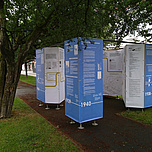Travelling Exhibition: "Topography of Resistance in Styria. 1936–1945"
Commemorating the 75th anniversary of the end of National Socialist rule in Austria students at the Institute of Architectural Theory, Art History and Cultural Studies worked in depth on the topic of National Socialist resistance during their master studio in Winter Semester 2019/20.
Under the guidance of Daniel Gethmann, Waltraud P. Indrist, Heimo Halbrainer, and Marie Fegerl the students focused on four representative locations in Styria—Deutschlandsberg, Eisenerz, Graz and Leoben—to document the different actions taken and the various forms of resistance. Methods of forensic architecture were used to reconstruct and map the traces of the resistance in the years 1936 to 1945. The project results are touring Styria between 9th June and 30th August in the form of a mobile exhibition:
Deutschlandsberg, Main Square: 9th to 21st June
Leoben, Main Square: 23rd June to 5th July
Graz, Museum für Geschichte/UMJ, Sackstraße 16: 7th to 19th July
Eisenerz, Dr.-Theodor-Körner-Platz: 18th to 30th August
Students involved: Lisa-Marie Dorfleitner, Janika Döhr, Ema Drnda, Flora Flucher, Max Frühwirt, Matthias Hölbling, Thomas Lienhart, Lung Peng, Thomas Tunariu, Anna Sachsenhofer, Alice Steiner, Milan Susic, Katharina Url, Viktoriya Yeretska and Armin Zepic
The exhibition was supported by:
The Faculty of Architecture at Graz University of Technology; Working Group of the Politically Persecuted (Concentration Camp Association—Styrian Regional Association of Austrian Anti-Fascists, Resistance Fighters and Victims of Fascism; The Austrian People’s Party’s Fellowship of the Politically Persecuted and Guarantors of Austria; Association of Social-Democratic Freedom Fighters, Victims of Fascism and Active Anti-Fascists); ARTEC group GmbH; the Institute of Architectural Theory, Art History and Cultural Studies (AKK); the Chambers of Architects and Chartered Engineering Consultants—Styria and Carinthia; timber company TILLY Holzindustrie Gesellschaft m.b.H.
LINK to the article of "Der Standard" about the touring exhibition: https://www.pressreader.com/austria/der-standard/20200512/281754156502794
Deutschlandsberg, Main Square

















